Question of the Week | Hypoglycemia Before Meal; Best Approach?

JR has type 1 diabetes and is worried how to best adjust insulin to address hypoglycemia and prevent future episodes. They tell you that their blood sugar yesterday before lunch was 67 mg/dL and they were getting ready to eat 45 gms of carb and cover with 3 units of insulin.
JR asks, what is the best strategy in this situation? What action do you advise JR to take?
- Eat 15 gms of carbohydrates first to get blood sugar above 70, then cover with three units of bolus insulin and eat meal.
- Decrease bolus insulin by about one unit, inject insulin then immediately eat meal.
- Eat intended meal starting with carbs first, then take three units of insulin after completing meal.
- All of the above could be options.
- Only A or B are correct.
Click Here to Test your Knowledge
Want to learn more about this practice question?
Join us LIVE in San Diego for our DiabetesEd Training Conference
October 11-13th, 2023

Two Registration Options
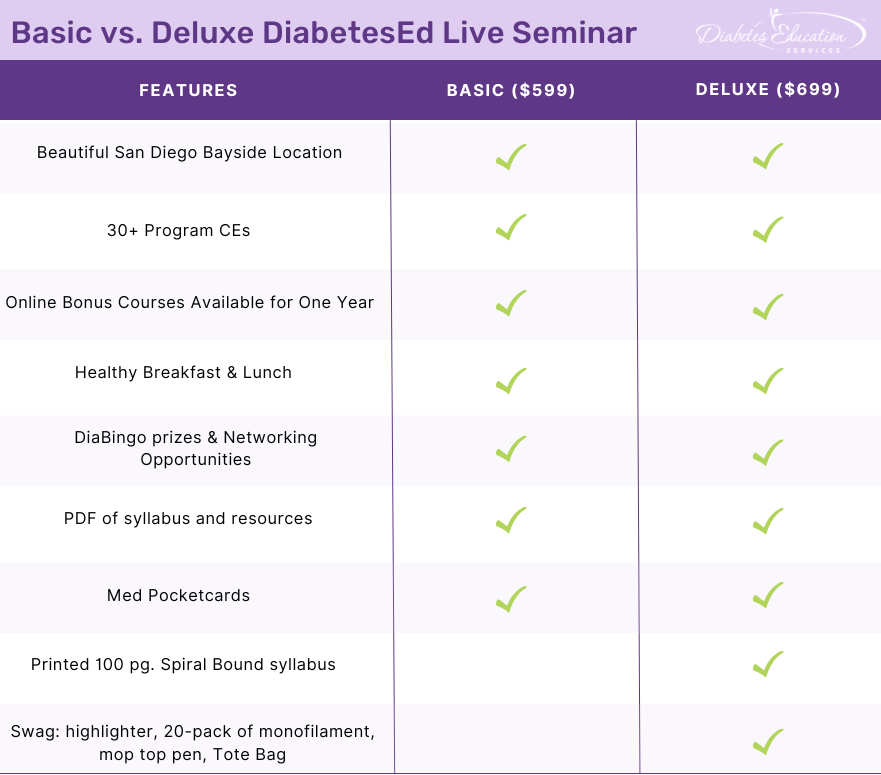
Join Coach Beverly and Team for two and a half days of knowledge-sharing, fun, networking, games with prizes, and “aha” moments in beautiful San Diego.
You don’t want to miss this one-of-a-kind learning opportunity. Get away from all those daily responsibilities and immerse yourself in a fun and intensive conference with plenty of networking opportunities.
Attendees will leave this conference with new tools and a more complete understanding of the latest advances in diabetes care, from medications to technology to Medical Nutrition Therapy!
Bring your colleagues and enjoy our friend discount.
Our team expertly translates the complex science of diabetes into understandable terms while keeping it real, practical, and fun.
Team of expert faculty includes:
- Diana Isaacs, PharmD, BCPS, BC-ADM, BCACP, CDCES – Educator of the Year, 2020
- Coach Beverly Thomassian, RN, MPH, CDCES, BC-ADM
- Ashley LaBrier, MS, RD, CDCES, Diabetes Program Coordinator
All hours earned count toward your CDCES Accreditation Information
Sign up for Diabetes Blog Bytes – we post one daily Blog Byte from Monday to Friday. And of course, Tuesday is our Question of the Week. It’s Informative and FREE! Sign up below!
The use of DES products does not guarantee the successful passage of the CDCES exam. CBDCE does not endorse any preparatory or review materials for the CDCES exam, except for those published by CBDCE.
August 2023 eNews | Keeping Cool with Diabetes & New FREE Podcasts?
Happy August

July has been an absolute scorcher. This extreme heat affects the health of vulnerable populations, including people with diabetes.
Our first newsletter article provides a concise summary of steps people with diabetes can take to keep safe during intense heat. Plus, we have included a FREE handout to share with your community.
Many people with diabetes are unaware that lancets and needles are considered hazardous waste and don’t know how to dispose of these sharps safely. We highlight an interactive website that provides safe disposal information customized by location.
To continue our 25 Year celebration, we are excited to announce our new FREE Podcast Series, “Diabetes Decoded with Coach Beverly.” Listen on-the-go to our nine available podcasts with more to come! Special thanks to my son, Jackson, for working over the summer to set up our Podcast station before heading off to study chemistry at UC Berkeley.
More celebrating with two free webinars this month— our new “Behavior Change Theories Made Easy” and our annual 3 Steps to DeFEET amputation. Invite your colleagues and join this fun learning opportunity.
Our updated Medication PocketCards are ready for shipping, and we invite you to challenge yourself with our Question and Rationale of the Week below.
We have more exciting swag and giveaway announcements coming soon as we continue to celebrate 25 years. Stay tuned!
With gratitude and appreciation,
Coach Beverly and Bryanna
Featured Articles
- Keeping Safe in the Heat
- Sharps Disposal Resources
- New: FREE Podcasts
- Updated Med Cards
- Question of the Week
- Rationale of the Week
- DiabetesEd Training October 11-13, San Diego
FREE Webinars & Resources
- New: FREE Webinars
- Prep for CDCES FREE Webinar on August 17th
- New: ADCES Review Guide Book
Upcoming Events – See the complete calendar listing
Join us LIVE in San Diego for our DiabetesEd Training Conference with 4 Hours of Medical Nutrition Therapy
October 11-13th, 2023

Join Coach Beverly and Team for two and a half days of knowledge-sharing, fun, networking, games with prizes, and “aha” moments in beautiful San Diego.
You don’t want to miss this one-of-a-kind learning opportunity. Get away from all those daily responsibilities and immerse yourself in a fun and intensive conference with plenty of networking opportunities.
Attendees will leave this conference with new tools and a more complete understanding of the latest advances in diabetes care, from medications to technology to Medical Nutrition Therapy!
Bring your colleagues and enjoy our friend discount.
Our team expertly translates the complex science of diabetes into understandable terms while keeping it real, practical, and fun.
Team of expert faculty includes:
- Diana Isaacs, PharmD, BCPS, BC-ADM, BCACP, CDCES – Educator of the Year, 2020
- Coach Beverly Thomassian, RN, MPH, CDCES, BC-ADM
- Ashley LaBrier, MS, RD, CDCES, Diabetes Program Coordinator
All hours earned count toward your CDCES Accreditation Information
Sign up for Diabetes Blog Bytes – we post one daily Blog Byte from Monday to Friday. And of course, Tuesday is our Question of the Week. It’s Informative and FREE! Sign up below!
The use of DES products does not guarantee the successful passage of the CDCES exam. CBDCE does not endorse any preparatory or review materials for the CDCES exam, except for those published by CBDCE.
Rationale of the Week | Post-Meal Hypoglycemia

For last week’s practice question, we quizzed participants on post-meal hypoglycemia. 69% of respondents chose the best answer. We want to clarify and share this important information, so you can pass it on to people living with diabetes and your colleagues, plus prepare for exam success!
Before we start though, if you don’t want any spoilers and haven’t tried the question yet, you can answer it below: Answer Question
Question:
JR has lived with type 1 diabetes for over 30 years and has been complaining that they feel full and bloated after eating and experiencing more post-meal hypoglycemia.
Based on this information, what is the most appropriate recommendation for JR?
Answer Choices:
- Evaluate transglutaminase levels.
- Encourage small, frequent, low fiber meals.
- Suggest a consult for a gastric pacemaker.
- Recommend they try avoiding foods with gluten for a few weeks to see if they feel better.
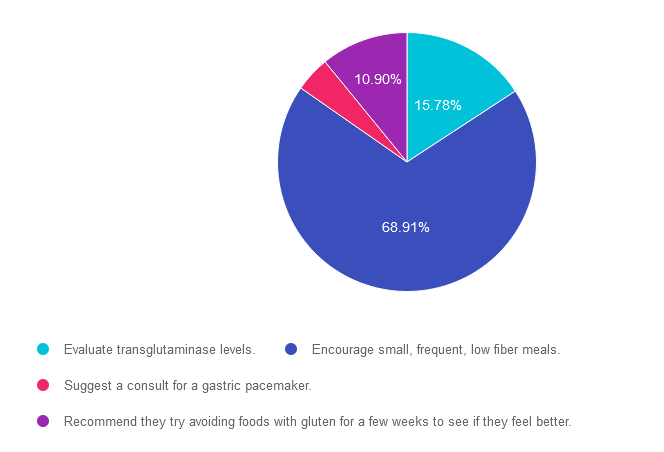
Getting to the Best Answer
If you are thinking about taking the certification exam, this practice test question will set you up for success. Test writers anticipate possible answers based on the details in the question. They will wave those “juicy answers” right under your nose. Your job is to weed through the particulars, pluck out the most important elements and choose the BEST answer.
Answer 1 is incorrect. 15.78% chose this answer. “Evaluate transglutaminase levels.” Based on JR’s symptoms of “feeling full and bloated after eating and experiencing more post-meal hypoglycemia” we are not suspecting celiac disease since there is no mention of bloating after gluten rich foods. Plus, post meal hypoglycemia is more likely associated with the delayed gastric emptying associated with gastroparesis. Since transglutaminase is a test used to detect celiac disease, this is not the best answer.
Answer 2 is correct. 68.91% of you chose this answer. “Encourage small, frequent, low fiber meals.” YES. GREAT JOB! JR’s symptoms of “feeling full and bloated after eating and experiencing more post-meal hypoglycemia” are both classic symptoms of gastroparesis and delayed gastric emptying. This autonomic neuropathic condition is treated with glucose improvement and smaller, low fiber meals to support gastric movement. In addition, a referral to a GI specialist is certainly warranted.
Answer 3 is incorrect. About 4.41% of respondents chose this. “Suggest a consult for a gastric pacemaker.” JR’s symptoms of “feeling full and bloated after eating and experiencing more post-meal hypoglycemia” are both classic symptoms of gastroparesis and delayed gastric emptying. This autonomic neuropathic condition is treated with glucose improvement and smaller, low fiber meals to support gastric movement. However, before suggesting a consult for a gastric pacemaker, JR would first need a referral to a GI specialist to confirm diagnosis and evaluate best next steps.
Finally, Answer 4 is incorrect. 10.90% chose this answer. “Recommend they try avoiding foods with gluten for a few weeks to see if they feel better.” Based on JR’s symptoms of “feeling full and bloated after eating and experiencing more post-meal hypoglycemia” we are not suspecting celiac disease since there is no mention of bloating after gluten rich foods. Plus, post meal hypoglycemia is more likely associated with the delayed gastric emptying associated with gastroparesis.
We hope you appreciate this week’s rationale! Thank you so much for taking the time to answer our Question of the Week and participate in this fun learning activity!
Want to learn more about this practice question?
Join us LIVE in San Diego for our DiabetesEd Training Conference
October 11-13th, 2023

Two Registration Options

Join Coach Beverly and Team for two and a half days of knowledge-sharing, fun, networking, games with prizes, and “aha” moments in beautiful San Diego.
You don’t want to miss this one-of-a-kind learning opportunity. Get away from all those daily responsibilities and immerse yourself in a fun and intensive conference with plenty of networking opportunities.
Attendees will leave this conference with new tools and a more complete understanding of the latest advances in diabetes care, from medications to technology to Medical Nutrition Therapy!
Bring your colleagues and enjoy our friend discount.
Our team expertly translates the complex science of diabetes into understandable terms while keeping it real, practical, and fun.
Team of expert faculty includes:
- Diana Isaacs, PharmD, BCPS, BC-ADM, BCACP, CDCES – Educator of the Year, 2020
- Coach Beverly Thomassian, RN, MPH, CDCES, BC-ADM
- Ashley LaBrier, MS, RD, CDCES, Diabetes Program Coordinator
All hours earned count toward your CDCES Accreditation Information
Sign up for Diabetes Blog Bytes – we post one daily Blog Byte from Monday to Friday. And of course, Tuesday is our Question of the Week. It’s Informative and FREE! Sign up below!
The use of DES products does not guarantee the successful passage of the CDCES exam. CBDCE does not endorse any preparatory or review materials for the CDCES exam, except for those published by CBDCE.
Fruit and Vegetable Prescriptions Improve Health

In a recent study published in Circulation, large, multisite produce prescription programs were associated with significant improvements in fruit and vegetable intake, food security, and health status for adults and children. At the conclusion of the food prescription program, participants experienced clinically relevant improvements in A1C, blood pressure, and body weight.
However, for this food-is-medicine strategy to work, it’s clear that the people will need long-term support.
The idea of food as medicine dates back to the ancient Greek doctor Hippocrates, and this new study adds to the evidence that a diet full of fruits and vegetables can help improve heart health.
Researchers evaluated the impact of “produce prescriptions,” which provide free fruits and vegetables to people with diet-related diseases including diabetes, obesity, and hypertension. The study included nearly 4,000 people in 12 states who struggle to afford healthy food. They received vouchers, averaging $63 a month, for up to 10 months, which could be redeemed for produce at retail stores or farmers markets, depending on the location.
Many people with diabetes struggle not only with food insecurity but also with nutrition insecurity. Improving nutrition security is about providing the right food to prevent or decrease the prevalence of chronic conditions like diabetes, heart disease and hypertension.
By providing adults with hypertension with access to healthy fruits and vegetables using a prescription program, this study demonstrated a systolic blood pressure decrease of 8 mm Hg and diastolic blood pressure decrease of about 5 mm Hg. In addition, among people with diabetes, A1C levels also declined significantly, by about 0.6 percent.
“Anything that lowers hemoglobin A1C and improves blood pressure control is beneficial,” says Dr. Dariush Mozaffarian, a cardiologist and professor at the Friedman School of Nutrition at Tufts University, where the research was conducted. The challenge is to maintain these reductions.
The research clearly indicates that food prescription programs are an effective strategy to improve health outcomes, but long-term funding for these programs is difficult to secure.
More research is needed to establish which individuals and communities will most benefit from which food assistance programs. Options include medically tailored meals, produce prescriptions, and community-based programs. The ultimate goal is to get to a place where these programs cover long-term benefits for people who need them most.
Resources and Related Articles
Wholesome Wave – partnering with community organizations to provide the right food to people at risk.
White House Conference on Hunger, Nutrition and Health
7 Ideas to Eat Healthier in the U.S.
Want to learn more about how nutrition can support people living with diabetes?
Join us LIVE in San Diego for our DiabetesEd Training Conference with Ashley LaBrier MS, RD, CDCES as she reviews MNT & Meal Planning

Two Registration Options

Join Coach Beverly and Team for two and a half days of knowledge-sharing, fun, networking, games with prizes, and “aha” moments in beautiful San Diego.
You don’t want to miss this one-of-a-kind learning opportunity. Get away from all those daily responsibilities and immerse yourself in a fun and intensive conference with plenty of networking opportunities.
Attendees will leave this conference with new tools and a more complete understanding of the latest advances in diabetes care, from medications to technology to Medical Nutrition Therapy!
Bring your colleagues and enjoy our friend discount.
Our team expertly translates the complex science of diabetes into understandable terms while keeping it real, practical, and fun.
Team of expert faculty includes:
- Diana Isaacs, PharmD, BCPS, BC-ADM, BCACP, CDCES – Educator of the Year, 2020
- Coach Beverly Thomassian, RN, MPH, CDCES, BC-ADM
- Ashley LaBrier, MS, RD, CDCES, Diabetes Program Coordinator
All hours earned count toward your CDCES Accreditation Information
Sign up for Diabetes Blog Bytes – we post one daily Blog Byte from Monday to Friday. And of course, Tuesday is our Question of the Week. It’s Informative and FREE! Sign up below!
The use of DES products does not guarantee the successful passage of the CDCES exam. CBDCE does not endorse any preparatory or review materials for the CDCES exam, except for those published by CBDCE.
From Pancreas Partners to Periodic Tables – Jackson Heads to College
My youngest son, Jackson, became a part-time employee for my company when he turned eight. Along with this older brother, he helped package DiaBingo kits, stuff, and stamp envelopes, assemble PocketCards, and choose Pancreas Partner color combinations. As Jackson entered his teen years, his contributions moved from simple assembly to innovation. Given his longstanding knowledge of our company goals, values, and community, he suggested changes that helped grow our social media presence and increase our connection with readers.
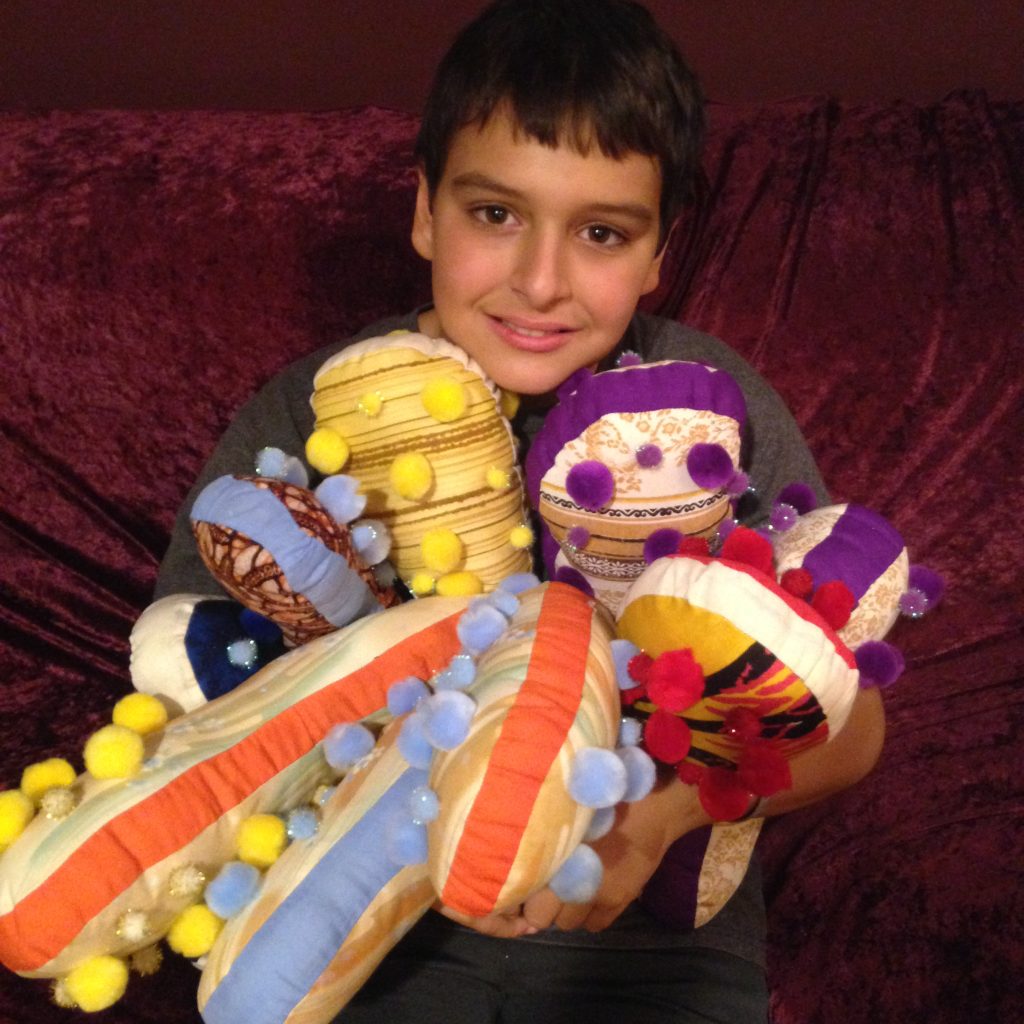
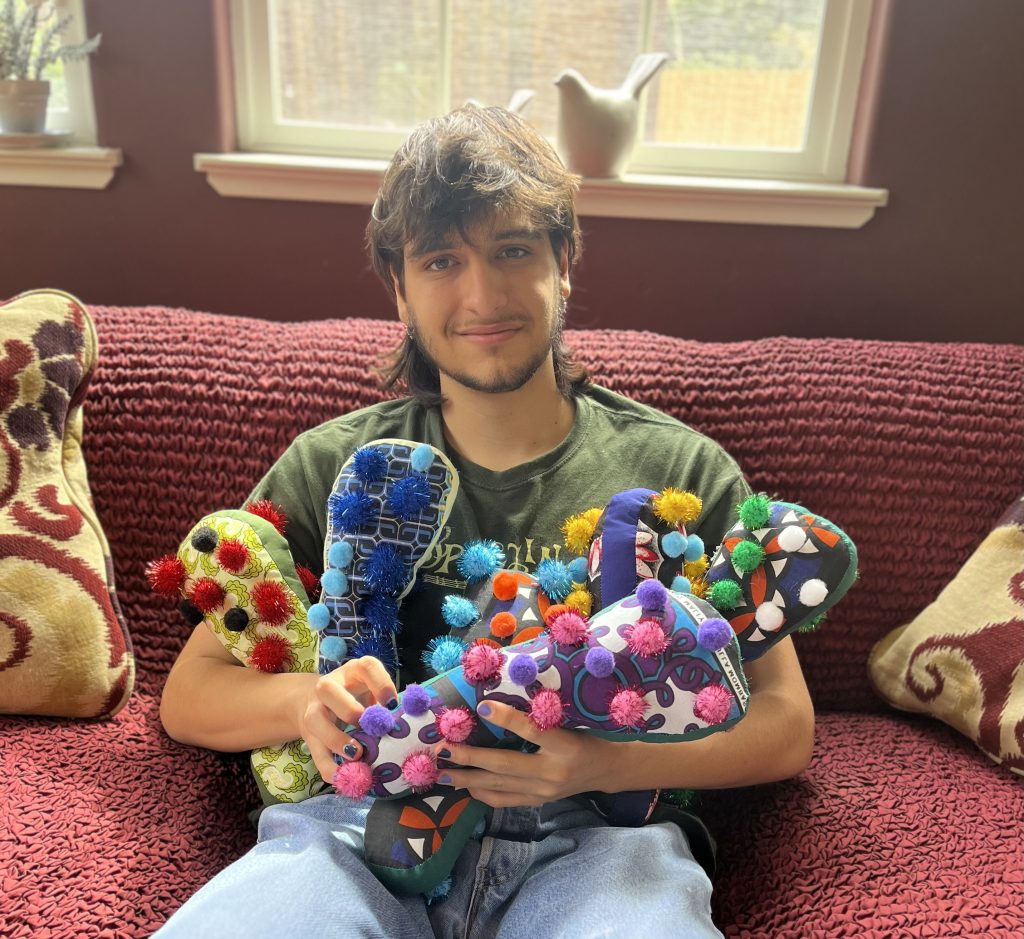
Over this past summer, in addition to answering customer questions, shipping out orders, and assembling our Pancreas Partners (see pictures), Jackson took a leadership role in creating our new Podcast offerings. He researched the best podcast platforms for our FREE webinars. By the end of summer, due to his vision and hard work, we launched all of our FREE Podcasts on the most popular platforms (such as Spotify, Amazon Music, Castbox, and Google Podcast).
Even though Jackson had an intense high school schedule due to his load of AP classes, running the Empowerment Club, playing in the jazz and marching bands, and taking the lead as Drum Major, he always showed up to work with a great attitude. During stressful periods at work, he managed to help me laugh, take a deep breath, and keep moving forward. He has a magical way of listening carefully, giving a hug, then gifting me with a goofy gesture that broke the tension and helped me regain a sense of calm.

Jackson fell in love with chemistry as a sophomore in high school. He was awarded a summer chemistry lab internship during his junior summer at a local Cal State University. As a full-time researcher for a few months, he said, “I feel like I have always been in the chemistry lab.” A few weeks ago, he kicked off his studies at UC Berkeley as a chemistry major and he is loving every minute of it.
I sure miss working alongside Jackson and goofing around with him. Yet, at the same time, I celebrate his new and exciting life while cheering him on from the sidelines. I am grateful for the time we spent together creating and exploring life and work from different angles and I can’t wait to see what the future holds!
As part of his legacy, Jackson recommended a close high school friend, named Ginger Nichols, to take over his job responsibilities. Ginger is a real go-getter and an absolute gem of a human. In addition to attending college full-time, she has a radio show, works another job, is involved in local theater, and has a terrific attitude. When I ask her how she is doing, she always responds, ‘I am doing great” and she means it!
Thank you Jackson for all your contributions to Diabetes Education Services over the years! We miss you and are so thankful that Ginger will be holding up your legacy of hard work and a great attitude combined with a boatload of kindness.
Our Teaching Tools make learning fun!
Pancreas Partner plus DiaCell
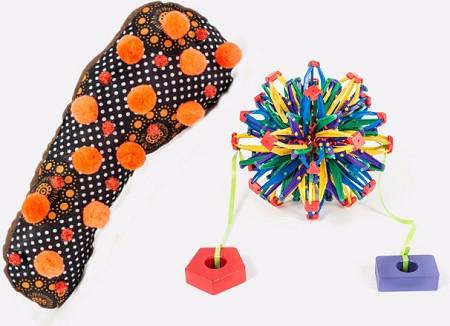
Explaining the pathophysiology of diabetes is no easy task. These fun and effective educational tools help you explain normal fuel metabolism and the defects associated with type 2 diabetes.
In addition, they can be used to motivate patients to lower blood glucose levels through diet, exercise, and medications.
Sign up for Diabetes Blog Bytes – we post one daily Blog Byte from Monday to Friday. And of course, Tuesday is our Question of the Week. It’s Informative and FREE! Sign up below!
The use of DES products does not guarantee the successful passage of the CDCES exam. CBDCE does not endorse any preparatory or review materials for the CDCES exam, except for those published by CBDCE.
Question of the Week | Preventing Hypo During Exercise

JR has type 1 and tells you they limit their carbohydrate intake to 30 gms a day to prevent hyperglycemia. Their A1C is 6.7% and time in range is over 70%. They tell you their main goal is to figure out how to prevent hypoglycemia during exercise.
What would be the best response using a person-centered approach?
- Explore how they are currently managing blood sugars around exercise.
- Reinforce that glucose needs to be above 100 mg/dL according to ADA Standards to prevent exercise induced hypoglycemia.
- Gently suggest referral to a RD to evaluate actual daily carbohydrate needs.
- Redirect the conversation to evaluate if JR might be experiencing disordered eating.
Click Here to Test your Knowledge
Want to learn more about this question?
ReVive 5 Diabetes Training Program
“ReVive 5 Program is the best program I have ever attended – should be required for all diabetes educators! Thank you so much for translating this research into practical approaches!!” – Sarah F.
Save $100! Enroll now to watch the webinar on-demand

ReViVE 5 Diabetes Training Program:
Unlocking Hidden Barriers to Diabetes Management
Enroll Now and Save $100!
Recorded & Ready to Watch
Addressing diabetes distress can be tricky, even for seasoned healthcare professionals.
We invite you to attend this hands-on training program that provides the essential steps to address diabetes distress combined with an innovative approach to glucose management. Our experts offer realistic strategies to address diabetes distress that you can immediately apply to your practice setting. Plus, the ReVive 5 Program provides a breadth of tools and resources to create more meaningful connections with people with diabetes.
Team of Experts: ReVive 5 is taught by a team of 3 Interdisciplinary Experts:
- Lawrence Fisher, Ph.D., ABPP, Professor Emeritus, UCSF
- Susan Guzman, PhD
- Beverly Thomassian, RN, MPH, CDCES, BC-ADM
Accredited Training Program:
- 15.0 CEs – Includes the 7-hour ReVive 5 Training Program, Certificate, and 5 FREE bonus courses to supplement content.
- A comprehensive set of assessment tools, educational materials, log sheets, and resources.
“ReVive 5” breathes new life into our relationship with diabetes, bringing a fresh perspective to both the person with diabetes and the provider.
All hours earned count toward your CDCES Accreditation Information
Sign up for Diabetes Blog Bytes – we post one daily Blog Byte from Monday to Friday. And of course, Tuesday is our Question of the Week. It’s Informative and FREE! Sign up below!
The use of DES products does not guarantee the successful passage of the CDCES exam. CBDCE does not endorse any preparatory or review materials for the CDCES exam, except for those published by CBDCE.
FREE Webinars in August with Coach Beverly
Coach Beverly is so excited about celebrating 25 years in business, that due to popular demand, she created a FREE course to de-mystify those complicated and confusing behavior change theories. Our community kept asking for this class and we are ready to deliver! In addition, we are thrilled to offer a FREE webinar designed to DeFEET Amputation, designed for all level of health care providers. Together, we CAN make a difference!
From Behavior Change Theory to hand’s on assessment of lower extremities, diabetes care and education specialists have so much to offer individuals living with diabetes.
Behavior Change Theories Made Easy
Airs live on August 23, 2023, at 11:30 am PT

Join us live on August 23rd from 11:30 am to 12:30 pm for our Free Webinar: Behavior Change Theories Made Easy
Keeping all the behavior change and learning theories straight can be daunting, especially if you are trying to get to the “best” answer for certification exams. Coach Beverly feels your pain and wants to help out. To say thanks for 25 years, she’s hosting a FREE Behavior Change Webinar to sort out and dissect the theories most relevant in clinical practice and for exam preparation.
Objectives:
- Describe 4 of the most common behavior change theories.
- Discuss how to apply these theories in clinical practice.
- List the steps in the transtheoretical model
- Have fun testing these theories out in real life.
Can’t make it live? No worries. We will send post the recorded version to the Online University within 24 hours of the broadcast
Two Ways to Register
Intended Audience: All health care professionals who are coaching individuals to support healthier self-management or who are taking the CDCES or BC-ADM exam.
All hours earned count toward your CDCES Accreditation Information
Instructor: Beverly Thomassian RN, MPH, CDCES, has been Board Certified in Advanced Diabetes Management for over 20 years. She is an Associate Clinical Professor at UCSF, a working educator, and a nationally recognized diabetes expert. She has a Master’s Degree in Public Health from UCLA, with a focus on behavioral health and education.
3 Steps to DeFEET Amputation; Assess, Screen, & Report | 1.0 CEs
Airs live on August 10, 2023, at 11:30 am PT

Coach Beverly will walk participants through the 3-Step Process to Save Feet; Assess, Screen, & Report. She will provide simple and clear instructions on how to assess and inspect feet, along with risk assessment & action steps. We will share free teaching tools, strategies, & documentation forms adapted from the Lower Extremity Prevention Program (LEAP) that you can immediately implement in your practice setting.
Objectives:
- Describe steps involved in effective foot assessment made easy.
- Demonstrate how to use a monofilament to assess sensation.
- Discuss the use of screening forms to report findings
Two Ways to Register
Intended Audience: This course is designed for all health care providers and educators, who are interested in learning more about assessing and saving feet in people living with diabetes.
All hours earned count toward your CDCES Accreditation Information
Instructor: Beverly Thomassian RN, MPH, CDCES, has been Board Certified in Advanced Diabetes Management for over 20 years. She is an Associate Clinical Professor at UCSF, a working educator, and a nationally recognized diabetes expert. She has a Master’s Degree in Public Health from UCLA, with a focus on behavioral health and education.
All hours earned count toward your CDCES Accreditation Information
On Sale Now – Save $90 on the
ADCES Art & Science Desk Reference 5th Edition
Only a few copies are left! Order now

The ADCES (formerly AADE) Art and Science of Diabetes Care and Education, 5th Edition is a specialist’s one-volume, go-to resource for the core knowledge and skills for providing person-centered care and education to persons with diabetes and related chronic conditions. This is a core resource for those who are studying for the Certified Diabetes Care and Education Specialist (CDCES) exam.
ADCES will be releasing an updated edition of the Art & Science Desk reference in August 2023
Sign up for Diabetes Blog Bytes – we post one daily Blog Byte from Monday to Friday. And of course, Tuesday is our Question of the Week. It’s Informative and FREE! Sign up below!
The use of DES products does not guarantee the successful passage of the CDCES exam. CBDCE does not endorse any preparatory or review materials for the CDCES exam, except for those published by CBDCE.
Save $50: Art & Science Desk Reference Book | Only a few left!
On Sale Now – Save $50 on the
ADCES Art & Science Desk Reference 5th Edition
Only a few copies are left! Order now

The ADCES (formerly AADE) Art and Science of Diabetes Care and Education, 5th Edition is a specialist’s one-volume, go-to resource for the core knowledge and skills for providing person-centered care and education to persons with diabetes and related chronic conditions. This is a core resource for those who are studying for the Certified Diabetes Care and Education Specialist (CDCES) exam.
ADCES will be releasing an updated edition of the Art & Science Desk reference in August 2023

Two Registration Options

Join Coach Beverly and Team for two and a half days of knowledge-sharing, fun, networking, games with prizes, and “aha” moments in beautiful San Diego.
You don’t want to miss this one-of-a-kind learning opportunity. Get away from all those daily responsibilities and immerse yourself in a fun and intensive conference with plenty of networking opportunities.
Attendees will leave this conference with new tools and a more complete understanding of the latest advances in diabetes care, from medications to technology to Medical Nutrition Therapy!
Bring your colleagues and enjoy our friend discount.
Our team expertly translates the complex science of diabetes into understandable terms while keeping it real, practical, and fun.
Team of expert faculty includes:
- Diana Isaacs, PharmD, BCPS, BC-ADM, BCACP, CDCES – Educator of the Year, 2020
- Coach Beverly Thomassian, RN, MPH, CDCES, BC-ADM
- Ashley LaBrier, MS, RD, CDCES, Diabetes Program Coordinator
All hours earned count toward your CDCES Accreditation Information
Sign up for Diabetes Blog Bytes – we post one daily Blog Byte from Monday to Friday. And of course, Tuesday is our Question of the Week. It’s Informative and FREE! Sign up below!
The use of DES products does not guarantee the successful passage of the CDCES exam. CBDCE does not endorse any preparatory or review materials for the CDCES exam, except for those published by CBDCE.








